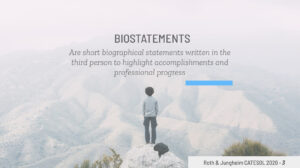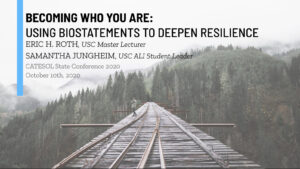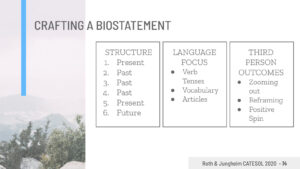1-310-390-0131 - Outside U.S.
Why Writing 3rd Person Biostatements Deepens Resilience

How we defined biostatements in our CATESOL 2020 presentation.
“We know what we are, but we know not what we may be.”
–William Shakespeare (1564-1616), English playwright
By Eric H. Roth & Samantha Jungheim
Can you tell your life story in a positive light? What have you achieved so far? What are you working on? What are your life goals?
Contemporary Reflection
These big questions encourage reflection. How can English teachers help students reflect on these existential questions? We recommend using biostatements.
At the CATESOL 2020 annual conference focused on resilience. Our 45-minute presentation showed how biostatements encourage critical reflection. Short biographical statements allow students to celebrate their successes. Biostatements can also help clarify and strengthen students’ professional aspirations. We also believe that writing biostatements in an English course can help students re-envision their next steps for a post-Covid world.

CATESOL 2020 Presentation on biostatement.
Why Biostatments?
Biostatements have become necessary piece for many professionals. Many English students and teaching professionals should, therefore, learn this essential writing skill. This short statement can also reinforce other lessons for English students, such as how to write for specific audiences, contexts, and purposes. In Eric’s graduate level writing course, students write biostatements for ConnectSC, the college job board for the University of Southern California. Students start by sharing their resumes and first person accounts of their experiences with a partner. Their classmate jots down quick notes and writes about their classmate in the third person. Starting with this synchronous activity scaffolds students to move from the first person (I) to the third (Feynman).
Valuable Learning Outcomes
Writing in third person provides a multitude of learning outcomes. Our CATESOL presentation focused on the learning outcomes of zooming out, reframing, and positive spin to shift students’ perspectives.
Primarily, students practice writing using:
- multiple verb tenses to describe past, present, and future biographical events
- action verbs
- transitions
- improve their article usage
These learning outcomes may seem lofty, but are manageable when covered over time.

Many possibilities for student learning outcomes.
Adaptable Activities
We encourage students to get to know themselves by listing skills they already possess and are learning how to do. Another class activity could involve looking at positive spin. Small groups or pairs can practice WH questions and modify their sentences to view their experiences through a positive lens. One example we used was how one student’s decision to change their majors multiple times could be interpreted various ways (i.e. as indecisive or inquisitive). We emphasize the power of choice and making students the hero of their own stories.
Details help persuade readers. Our presentation asserts that biostatements should be anchored in dates, and students should consider their audiences when determining what details to include in their biostatements. What awards or scholarships have they won? When did they graduate from college? Where was their last internship?
Additionally, biostatements can also enhance students’ editing skills. Multiple drafts, peer review sessions, and teacher feedback provide students’ all provide opportunities to upgrade their vocabulary and grammar. Rough drafts are seldom final drafts.
Concluding Thoughts
We concluded our presentation sharing reproducible handouts for peer, self, and teacher evaluations. The participants shared immediate positive responses to our presentation. We believe biostatements are an effective way to build classroom rapport and develop student’s academic and professional writing skills.
What skills do you want to highlight in your biostatement? What activities help build rapport in your classroom?
Ask more. Know more. Share more.
Create Compelling Conversations.

